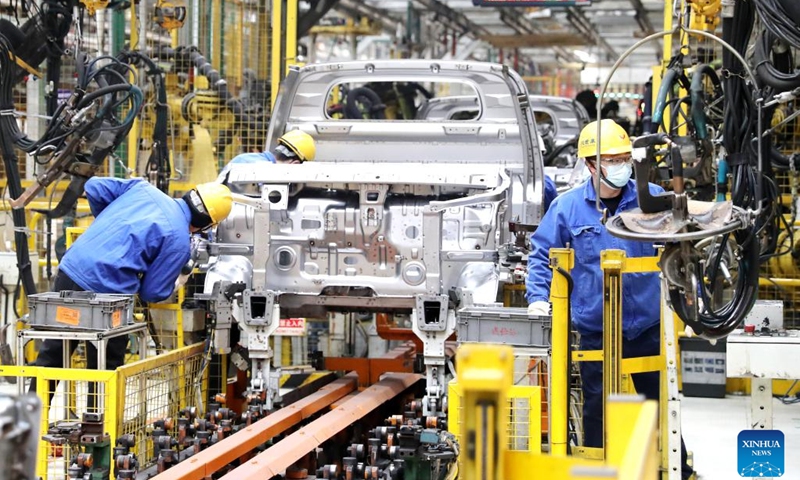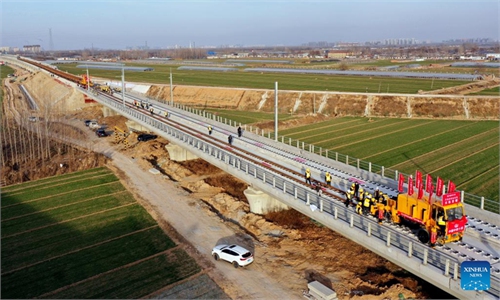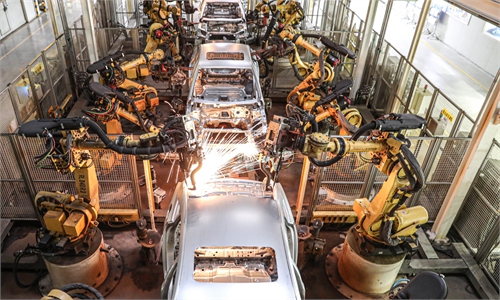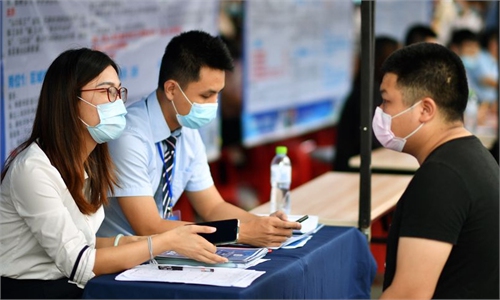China's manufacturing, services sectors back in expansion territory in January, after December reopening
Optimization of COVID response spurs new dynamic

Staff members work at a workshop of an auto manufacturing enterprise in Qingdao, east China's Shandong Province, Jan. 28, 2023. Factories and companies across China resumed work after the Spring Festival holiday.(Photo: Xinhua)
China's factory and services activity expanded for the first time in four months in January -- one of the first signs of economic recovery after the country's optimization of coronavirus management in December.The official manufacturing purchasing managers' index (PMI) bounced back into expansion territory at 50.1 in January from 47 in December, data released by the National Bureau of Statistics showed on Tuesday.
The figure beat a consensus forecast of 49.8 by 25 economists polled by Reuters.
The manufacturing PMI shows the prevailing trend in the manufacturing sector. Generally, an index reading above 50 indicates expansion, while a reading below indicates contraction.
China's manufacturing PMI hit 50.1 in September, but it was stuck in contraction in the following months, as the economy faced downward pressure caused by strict pandemic restrictions.
However, since China optimized its COVID-19 response in December, demand has snapped back and supply chains have stabilized, lifting the manufacturing sector across the board.
The rebound in the manufacturing PMI was mainly led by a recovery in the new orders sub-index to 50.9 from 43.9, which pointed to improving market demand. The logistics situation also improved, with the suppliers' delivery time sub-index jumping to 47.6 from 40.1.
Several companies that Global Times recently interviewed said that their orders are growing.
A business manager with a Ningbo-based company surnamed Jiang said that the firm exported around 700 million yuan ($104 million) worth of products last year, which may reach 1 billion yuan this year.
China's manufacturing sector is leading the world's manufacturing rankings, Wu Tong, an official with the World Economic Forum, told the Global Times in a group interview.
The PMI for China's non-manufacturing sector picked up much more significantly to 54.4 from the December level of 41.6, mainly driven by the services sub-index, which jumped to 54.0 in January from a record low of 39.4 in December.
Consumption ranging from tourism to theater screenings surged during the 2023 Spring Festival holidays, with some sectors recording their highest earnings in the past three years.
"The expansion of China's factory and services activity sends a clear signal that China's economy is recovering rapidly, consumer demand is increasing and investors' confidence in the economy is rising," Hong Yong, a research fellow with the Chinese Academy of International Trade and Economic Cooperation, told the Global Times.
Yue Xiangyu, an analyst at the Shanghai University of Finance and Economics, said that the improved PMI shows that China's business operations and consumer activity are "restarting" as market demand is increasing, following a recent peak of COVID infections.
As China's economy shows signs of a strong recovery, overseas institutions are displaying increasing confidence in the country's economic outlook.
Japan-based Nomura said in a note it sent to the Global Times that it expects both the manufacturing and non-manufacturing PMIs to rise even higher, as more people adapt to living with COVID, manufacturing activity accelerates after the Spring Festival holidays, and recovery momentum gains pace.
The IMF on Monday projected China's economy will grow by 5.2 percent in 2023, 0.8 percentage points higher than the October 2022 forecast.
"Overseas confidence in China's economic recovery is getting stronger, shown by a continued inflow of capital into Chinese equities, as well as the rising trend of offshore yuan," Yue said, adding that this is mainly because they think that China's economy has bottomed out, while the US is likely to slip into a recession.



